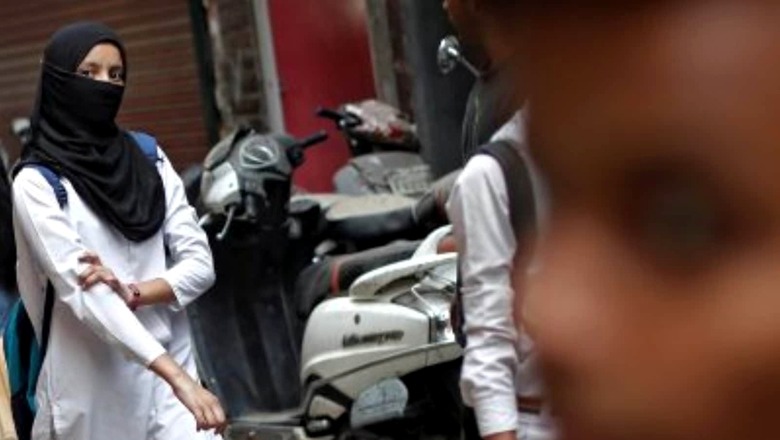
views
Recently, we saw disturbing reports about a group of teenager Muslim girls in hijab being denied entry into classroom by their educational institute in Udupi, Karnataka. The college authorities insist that students must comply with the uniform which doesn’t permit hijab in classroom. The girls in hijab have been staging a democratic protest inside the campus, defending their Right to Education as well as their right to wear hijab.
In a religiously polarized climate, it is not surprising that the issue has got politicized with ministers jumping into the fray. While the college authorities are free to decide their own rules, they cannot be violative of fundamental rights granted by the Constitution.
Constitutionally speaking, this is an open and shut case of Right to Education as well as Right to Religious Freedom. Whether it is mere overstepping by college authorities or yet another case of Islamophobia, singling out girls in hijab, is difficult to tell.
Let us consider a third dimension to this impasse. The parents would not permit the girls to go to college without hijab and the authorities would deny them entry because of hijab. In either case, girls’ education is bound to suffer. Religious symbols in public life have always been a significant question in our multi-faith society. It assumes greater significance in a religiously charged and polarised atmosphere we live in today.
Controversies over religious symbols in public places, such as hijab or Jewish kippah or Christian cross, are not new globally. There was a huge furore some years ago when France legally banned these in public places including schools and government offices. For the French, such religious symbols are violative of the secularism they adhere to in public life.
But clearly, in our country, we do not practice the French variety of secularism. Right to Religious Freedom is as much a tenet of our democracy as is secularism. Singling out hijab for criticism would be unfair. Those opposing it are not known for their fondness of secularism either. Students affiliated to politically-backed outfits have started wearing saffron scarves to counter the girls in hijab. Secularism is an outdated political practice with politicians making a beeline to visit temples before every election.
When divisive politics threatens peace and social harmony, it becomes necessary for we, the people, to play a proactive role. Common Hindus and Muslims must begin to question the harm caused in the name of religion. If we don’t wake up even now, we are somehow complicit in the divisive politics. Hijab to saffron scarves, the question of who decides what comprises faith is bound to arise. It is important to abide by the essential practices’ principle and leave religion in the private realm. The increasing numbers of Hindus and Muslims wearing religion on their sleeves would cause further polarisation in society and expand the influence of those indulging in politics of religion.
Just as Hindu women and indeed men too must question the diktats on bindi or against jeans, similarly Muslim women too should reflect on the fundamentals of hijab. Unless we begin doing this, the public discourse will be forever caught in the trap of extreme binaries along expected lines.
But should a Muslim woman necessarily wear a hijab? Fatima Mernissi, Moroccan feminist scholar who did path-breaking research into the origins of hijab and burqa, elaborately studied the occurrence of the Arabic word sitr in the religious texts and its various meanings, ranging from curtain to physical barrier to simple cover depending on the context. She also counted that on most occasions, sitr applied to men in various social situations and milieu.
She established how over centuries of male-dominated social order across Muslim societies, the sitr or covering came to be exclusively applied to women, leading to today’s understanding. She ably illustrated how patriarchy systematically distorted religious teachings and constructed myths leading to norms that confine women.
Although Indian Muslims are not a monolith theologically and culturally speaking, there has been a noticeable rise of religiosity in the last few decades. Many have come under the influence of Wahabism which insists on overt religiosity as visible in dress codes for men, women and even little children.
Today there are many more women and young girls in head-to-toe burqa. Several more are in hijab. Girls whose grandmothers or mothers never wore a hijab are embracing hijab today. Of course, it was common practice in Muslim societies for elderly women to throw a wide dupatta loosely over their shoulders and heads. Both my grannies and other elderly women in the neighbourhood followed this practice of their own volition. They were not at all anxious that not a strand of their hair should be visible!
Today, I commonly hear a girl saying that hijab is my personal choice. It is my hope that someday she will realise that she had no choice really. She will realise that she got swayed by the premium being put on a hijab-clad woman in our society. A woman in hijab is a good woman because she is “appropriately dressed”. In my activism for Muslim women rights, I regularly get asked the question, “but why are you not in an Islamic dress!”
Collectively, Indian Muslims have never deliberated on issues connected with Islam, culture and identity. Invariably, the popular common sense has been based on conservatism and patriarchal worldview. A serious collective reflection on questions such as multiculturalism is overdue. It must be done with the same vigour with which we demand justice and equality as citizens.
The author is co-founder of Bharatiya Muslim Mahila Andolan. The views expressed in this article are those of the author and do not represent the stand of this publication.
Read all the Latest Opinions here




















Comments
0 comment